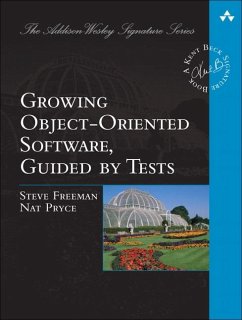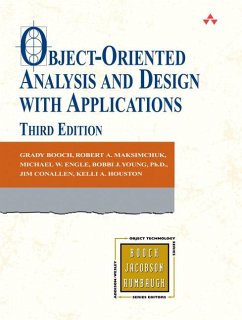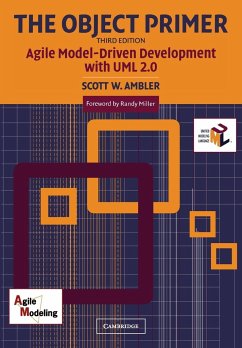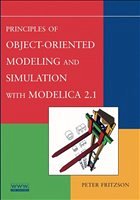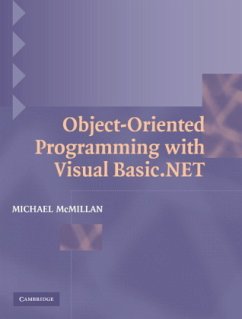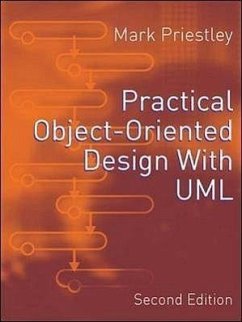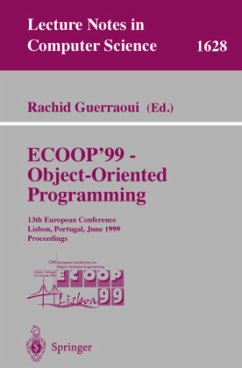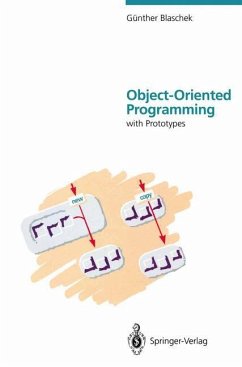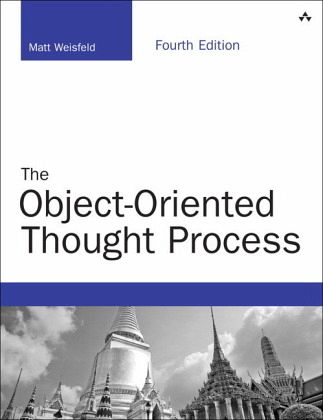
The Object-Oriented Thought Process
Versandkostenfrei!
Liefertermin unbestimmt
27,99 €
inkl. MwSt.
Object-oriented programming is the foundation of nearly all modern software languages, from Java and C# to Ruby and PHP5. Its powerful advantage range from productivity and maintainability to portability and reuse. But to take full advantage of objects, it's not enough for programmers to apply rote techniques: they must master a truly object-oriented thought process.
Thousands of developers have gained that deep mastery from Matt Weisfeld's Object-Oriented Thought Process. Now, Weisfeld has extensively updated this solutions-oriented primer to reflect the newest languages, applications, and program design techniques. Through ingenious code examples written in Java, current .NET languages, and Objective-C 2.0, Weisfeld illuminates concepts ranging from abstraction to public and private classes. He offers deep insight into code reuse and framework development, and helps programmers build objects that work well with databases and distributed systems. New coverage includes:
* A revamped chapter on portable data, with new coverage of XML, SOAP, JSON and related technologies
* Extensive updates to the chapter on persistent data in networked environments
* An all-new chapter on web services and mobile app development
* Coverage of unit testing in every chapter, reflecting its crucial importance to object-oriented design
This edition also supports instructors with extensive downloadable instructional materials.
Product Description
The Object-Oriented Thought Process, Fourth Edition
An introduction to object-oriented concepts for developers looking to master modern application practices
Object-oriented programming (OOP) is the foundation of modern programming languages, including C++, Java, C#, Visual Basic .NET, Ruby, and Objective-C. Objects also form the basis for many web technologies such as JavaScript, Python, and PHP.
It is of vital importance to learn the fundamental concepts of object orientation before starting to use object-oriented development environments. OOP promotes good design practices, code portability, and reuse–but it requires a shift in thinking to be fully understood. Programmers new to OOP should resist the temptation to jump directly into a particular programming language (such as Objective-C, VB .NET, C++, C# .NET, or Java) or a modeling language (such as UML), and instead first take the time to learn what author Matt Weisfeld calls “the object-oriented thought process.”
Written by a developer for developers who want to make the leap to object-oriented technologies, The Object-Oriented Thought Process provides a solutions-oriented approach to object-oriented programming. Readers will learn to understand the proper uses of inheritance and composition, the difference between aggregation and association, and the important distinction between interfaces and implementations.
While programming technologies have been changing and evolving over the years, object-oriented concepts remain a constant–no matter what the platform. This revised edition focuses on interoperability across programming technologies, whether you are using objects in traditional application design, in XML-based data transactions, in web page development, in mobile apps, or in any modern programming environment.
“Programmers who aim to create high quality software–as all programmers should–must learn the varied subtleties of the familiar yet not so familiar beasts called objects and classes. Doing so entails careful study of books such as Matt Weisfeld’s The Object-Oriented Thought Process.”
–Bill McCarty, author of Java Distributed Objects, and Object-Oriented Design in Java
Contents at a Glance
1 Introduction to Object-Oriented Concepts
2 How to Think in Terms of Objects
3 Advanced Object-Oriented Concepts
4 The Anatomy of a Class
5 Class Design Guidelines
6 Designing with Objects
7 Mastering Inheritance and Composition
8 Frameworks and Reuse: Designing with Interfaces and Abstract Classes
9 Building Objects and Object-Oriented Design
10 Creating Object Models
11 Objects and Portable Data: XML and JSON
12 Persistent Objects: Serialization, Marshaling, and Relational Databases
13 Objects in Web Services, Mobile Apps, and Hybrids
14 Objects and Client/Server Applications
15 Design Patterns
Features + Benefits
Clear, concise, accessible: the best way to succeed with objects in any language -- from Java to C#, Objective-C to modern scripting languages
Thousands of developers have gained that deep mastery from Matt Weisfeld's Object-Oriented Thought Process. Now, Weisfeld has extensively updated this solutions-oriented primer to reflect the newest languages, applications, and program design techniques. Through ingenious code examples written in Java, current .NET languages, and Objective-C 2.0, Weisfeld illuminates concepts ranging from abstraction to public and private classes. He offers deep insight into code reuse and framework development, and helps programmers build objects that work well with databases and distributed systems. New coverage includes:
* A revamped chapter on portable data, with new coverage of XML, SOAP, JSON and related technologies
* Extensive updates to the chapter on persistent data in networked environments
* An all-new chapter on web services and mobile app development
* Coverage of unit testing in every chapter, reflecting its crucial importance to object-oriented design
This edition also supports instructors with extensive downloadable instructional materials.
Product Description
The Object-Oriented Thought Process, Fourth Edition
An introduction to object-oriented concepts for developers looking to master modern application practices
Object-oriented programming (OOP) is the foundation of modern programming languages, including C++, Java, C#, Visual Basic .NET, Ruby, and Objective-C. Objects also form the basis for many web technologies such as JavaScript, Python, and PHP.
It is of vital importance to learn the fundamental concepts of object orientation before starting to use object-oriented development environments. OOP promotes good design practices, code portability, and reuse–but it requires a shift in thinking to be fully understood. Programmers new to OOP should resist the temptation to jump directly into a particular programming language (such as Objective-C, VB .NET, C++, C# .NET, or Java) or a modeling language (such as UML), and instead first take the time to learn what author Matt Weisfeld calls “the object-oriented thought process.”
Written by a developer for developers who want to make the leap to object-oriented technologies, The Object-Oriented Thought Process provides a solutions-oriented approach to object-oriented programming. Readers will learn to understand the proper uses of inheritance and composition, the difference between aggregation and association, and the important distinction between interfaces and implementations.
While programming technologies have been changing and evolving over the years, object-oriented concepts remain a constant–no matter what the platform. This revised edition focuses on interoperability across programming technologies, whether you are using objects in traditional application design, in XML-based data transactions, in web page development, in mobile apps, or in any modern programming environment.
“Programmers who aim to create high quality software–as all programmers should–must learn the varied subtleties of the familiar yet not so familiar beasts called objects and classes. Doing so entails careful study of books such as Matt Weisfeld’s The Object-Oriented Thought Process.”
–Bill McCarty, author of Java Distributed Objects, and Object-Oriented Design in Java
Contents at a Glance
1 Introduction to Object-Oriented Concepts
2 How to Think in Terms of Objects
3 Advanced Object-Oriented Concepts
4 The Anatomy of a Class
5 Class Design Guidelines
6 Designing with Objects
7 Mastering Inheritance and Composition
8 Frameworks and Reuse: Designing with Interfaces and Abstract Classes
9 Building Objects and Object-Oriented Design
10 Creating Object Models
11 Objects and Portable Data: XML and JSON
12 Persistent Objects: Serialization, Marshaling, and Relational Databases
13 Objects in Web Services, Mobile Apps, and Hybrids
14 Objects and Client/Server Applications
15 Design Patterns
Features + Benefits
Clear, concise, accessible: the best way to succeed with objects in any language -- from Java to C#, Objective-C to modern scripting languages
Written by a developer for students who want to make the leap to object-oriented technologies, The Object-Oriented Thought Process, 4/e provides a solutions-oriented approach to object-oriented programming. Students will learn to understand the proper uses of inheritance and composition, the difference between aggregation and association, and the important distinction between interfaces and implementations.
While programming technologies have been changing and evolving over the years, object-oriented concepts remain a constantGÇöno matter what the platform. This revised edition focuses on interoperability across programming technologies, whether students are using objects in traditional application design, in XML-based data transactions, in web page development, in mobile apps, or in any modern programming environment.
While programming technologies have been changing and evolving over the years, object-oriented concepts remain a constantGÇöno matter what the platform. This revised edition focuses on interoperability across programming technologies, whether students are using objects in traditional application design, in XML-based data transactions, in web page development, in mobile apps, or in any modern programming environment.





